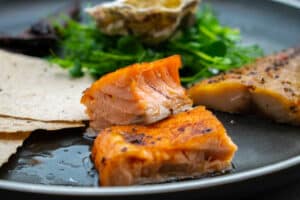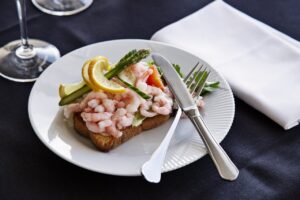New Nordic Cuisine is a groundbreaking food trend that has taken the culinary world by storm. Its emphasis on fresh, local ingredients, innovative cooking techniques, and bold flavors have made it one of the most talked-about cuisines in the world.
In this delicious exploration of New Nordic Cuisine, we’ll uncover its roots and defining features, taste its delicious offerings, and discover the secrets behind its success.
If you find yourself becoming increasingly hungry for a Nordic adventure while you read, check out our luxury Scandinavia tour packages after you finish. Our expert trip planners have created immersive experiences that showcase the very best of the region — including the food!
If you have any questions for us, please feel free to get in touch. For now, though, let’s embark on a sensory journey and uncover the wonders of New Nordic Cuisine!
What is New Nordic Cuisine and How Does it Differ from Other Regional Cuisines?

New Nordic Cuisine is a modern interpretation of traditional Scandinavian cooking. It promotes using fresh, local, and seasonal ingredients and emphasizes sustainability. René Redzepi of Noma is one of the movement’s major proponents, and it has gained immense recognition worldwide.
This modern cuisine is all about enjoying the simple pleasures of food — it is not about overcomplicating or creating overly extravagant dishes.
New Nordic Cuisine differs from other regional fares in its focus on sustainability and its emphasis on local ingredients. It puts a modern spin on traditional Scandinavian cooking while respecting the region’s culinary traditions.
Unlike other regional cuisines, which may have elaborate dishes full of complicated ingredients, New Nordic Cuisine favors simple dishes that exist in harmony with nature. This food movement is about letting flavors shine and using local natural resources respectfully.
For a broader look at Nordic cuisine, be sure to read our blog Food in Scandinavia.
The History of New Nordic Cuisine
New Nordic Cuisine has its roots in a 2004 movement started by a group of Nordic chefs, including the renowned René Redzepi of Noma. This movement sought to create a modern and respectful cuisine based on the region’s culinary traditions.
The primary focus was on sustainability, fresh ingredients, and simplicity. By 2007, the movement had gained traction and was gaining recognition around the world.
Since then, New Nordic Cuisine has grown in popularity and has become increasingly influential on the global food scene. In 2012, the New Nordic Cuisine Manifesto was drafted to provide guidelines for Nordic chefs and promote the principles of sustainability and local ingredients.
As a result of its emphasis on sustainability and use of traditional ingredients, New Nordic Cuisine has become a popular culinary style today.
The Top Chefs Redefining the Flavors of the Region

The Nordic region is home to world-famous chefs who are pushing the boundaries of modern cuisine and redefining the region’s flavors. The aforementioned René Redzepi is one of the pioneers of the New Nordic Cuisine movement. His restaurant, Noma, has earned two Michelin stars.
Other notable chefs include Magnus Nilsson and Magnus Ek from the since-closed Faviken and Oaxen Krog, respectively. Nilsson creates dishes centering on traditional Nordic cuisine, while Ek’s specialty is his innovative cuisine and unique take on classic Nordic dishes. Both chefs have been highly influential in the invention and development of New Nordic Cuisine.
In addition to these chefs, the Nordic region is home to many other talented chefs who are redefining the region’s flavors. From classic Scandinavian dishes to modern interpretations of traditional cuisine, these chefs make the Nordic region a global culinary destination.
One of the best ways to sample the culinary variations of the Nordic region is to visit multiple countries in a single trip. Our Scandinavian multi-country tours are the perfect way to make this happen! With our carefully crafted itineraries, you can sample the tastes of Denmark, Norway, Sweden, and more.
Five Local Ingredients that Make New Nordic Cuisine Uniquely Delicious

New Nordic Cuisine is becoming increasingly popular because it combines traditional Nordic ingredients with modern cooking methods and flavors. A key characteristic of this type of cuisine is its focus on foraged, local, and sustainable ingredients.
Five of the ingredients that make New Nordic Cuisine uniquely delicious include:
- Wild Produce: The Nordic region is home to wild mushrooms, berries, nettles, and much more. Chefs use these ingredients to create unique dishes that are full of flavor.
- Smoked Fish and Game Meats: It is common for Nordic chefs to smoke fish and game meats to preserve them and create flavorful dishes. Smoked salmon and elk are particularly popular.
- Foraged Ingredients: Chefs in the Nordic region often forage for wild ingredients, such as seaweed, juniper berries, and wild herbs. Using these foraged foods helps to make dishes with complex and unique flavors.
- Root Vegetables: Root vegetables, or “root crops,” such as carrots and potatoes, are staples of Nordic cuisine. These vegetables are often combined with smoked meats or fish to create hearty dishes.
- Dairy Products: Dairy products like cheese and butter are staples of the Nordic diet. Many traditional dishes, such as smørrebrød, use dairy products to enhance their flavor by creating creamy sauces.
These five local ingredients are key components of the New Nordic Cuisine and help to make regional dishes uniquely delicious.
It’s easy to feel overwhelmed when learning about a new destination. If you want to ground yourself in some useful, bitesize information from our Scandinavia specialists, read our Scandinavia Guide for First-Time Travelers.
Traditional Dishes of New Nordic Cuisine That Every Food Lover Should Try

New Nordic Cuisine combines traditional recipes and modern cooking techniques to create dishes that are as unique as they are delicious.
Just a handful of our favorite dishes at Discover Scandinavia Tours include:
- Smørrebrød: This traditional Danish open-faced sandwich is made from dense rye bread and topped with fish, meats, and vegetables.
- Gravlax: A cured salmon dish often served with dill and mustard sauces.
- Pickled Herring: A traditional Scandinavian dish often flavored with onion, dill, and mustard.
- Fisksoppa: A traditional Swedish fish soup made with whitefish, potatoes, and onions.
- Stekt Ris: A traditional Norwegian dish with rice, bacon, and onions.
- Karelian Hot Pot: A traditional Finnish dish with beef or pork, potatoes, and carrots.
- Reindeer Stew: A traditional Lapland dish with reindeer, root vegetables, and mushrooms.
- Blodpølse: A traditional Norwegian blood sausage.
These traditional dishes demonstrate the region’s commitment to sustainability and local produce while incorporating global flavors. Every food lover should try these dishes to experience the unique flavors of New Nordic Cuisine.
Restaurants Serving New Nordic Cuisine
The most popular restaurants in Scandinavia serving New Nordic cuisine include:
- Noma, Copenhagen, Denmark – René Redzepi’s two Michelin-starred restaurant is widely considered the pioneer of New Nordic Cuisine.
- Maaemo, Oslo, Norway – Maaemo is one of the most renowned restaurants in Norway and is known for its focus on local and seasonal produce.
- Koks, Faroe Islands – This Michelin-starred restaurant serves traditional Faroese cuisine with a modern twist.
- Geranium, Copenhagen, Denmark – Geranium is a Michelin-starred restaurant focusing on sustainability and seasonal ingredients.
- Olo, Helsinki, Finland – Olo is a Michelin-starred restaurant where you can choose from the seasonal 6- or 9-course menus containing innovative dishes packed with flavor.
- bhoga, Gothenburg, Sweden – This Michelin-starred restaurant invites a uniquely Nordic food experience in connection with locally-grown seasonal ingredients.
While securing reservations at these Michelin-starred restaurants can often be difficult, there are many hidden gems to discover. Check out our 2023 Restaurant Guide for some expert recommendations.
Nordic Adventures Await with Our Scandinavia Tours
We hope you’ve enjoyed this guide to New Nordic Cuisine. If it has stirred your wanderlust, head over to our range of luxury Scandinavia tour packages and browse our itineraries. There’s a Nordic vacation waiting for you!
Do you have any questions for us? Please get in touch for all the answers you need.